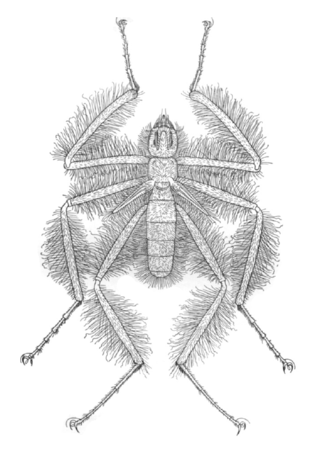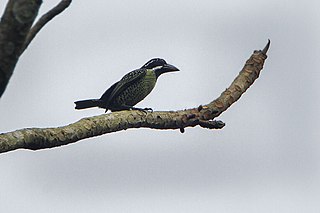
Nepenthes hirsuta, the hairy pitcher-plant, is a tropical pitcher plant endemic to Borneo. It is characterised by an indumentum of thick brown hairs, which is even present on the inflorescence. Pitchers are mostly green throughout with some having red blotches on the inside surfaces.

The family Mormotomyiidae contains only one known species, Mormotomyia hirsuta, commonly known as the frightful hairy fly or terrible hairy fly, which is found in Kenya. The fly was first described by English entomologist Ernest Edward Austen, and specimens have been collected from one location on a mountain in the Ukasi Hill, in a cleft where a bat roost is located; this may possibly be the most restricted geographic distribution for any fly family. The larvae have been collected from bat guano. Adult flies are believed to feed on bodily secretions of bats. The fly measures about 1 cm long, with hairy legs, and, due to its nonfunctional wings and tiny eyes, looks more like a spider than a fly. Specimens have been collected only three times, in 1933, 1948, and 2010. Tested members of the population showed higher levels of genetic variation than would be expected for such a restricted range, suggesting that additional undiscovered populations exist with gene flow occurring between them and the known population in Ukasi Hill.

Kiwa hirsuta is a crustacean discovered in 2005 in the South Pacific Ocean. This decapod, which is approximately 15 cm (5.9 in) long, is notable for the quantity of silky blond setae covering its pereiopods. Its discoverers dubbed it the "yeti lobster" or "yeti crab".

Cardamine hirsuta, commonly called hairy bittercress, is an annual or biennial species of plant in the family Brassicaceae, and is edible as a salad green. It is common in moist areas around the world.

Nepenthes hispida is a tropical pitcher plant species native to Borneo. It grows at elevations of 100 to 800 m in kerangas forest. It is known with certainty only from Lambir Hills National Park and surrounding areas.

The hairy big-eared bat is a bat species from South and Central America, as well as Trinidad and Tobago in the Caribbean.

Hypoxis hirsuta, commonly known as common goldstar, common star-grass, eastern yellow stargrass, yellow star grass, or yellow star flower, is a perennial ornamental plant in the family Hypoxidaceae. Sometimes this plant is placed in the family Amaryllidaceae or the family Liliaceae. The species is native to the United States, Canada, and northeastern Mexico.

Arabis hirsuta, known as hairy rock-cress, is a flowering plant in the family Brassicaceae. In previous North American works, this species has been broadly defined to include plants native to Europe, Asia, and the northern half of North America, but is now more often restricted to a narrower subgroup restricted to Europe.

The hairy-breasted barbet is a species of bird in the family Lybiidae. It is found throughout the African tropical rainforest.

Persoonia hirsuta, commonly known as the hairy geebung or hairy persoonia, is a species of flowering plant in the family Proteaceae. It is endemic to eastern New South Wales, Australia. It is a hairy, spreading to low-lying shrub with linear, lance-shaped or spatula-shaped leaves and yellow or orange flowers arranged singly or in groups of up to ten on a rachis up to 20 mm (0.79 in) long.

Sophronica is a genus of longhorn beetles of the subfamily Lamiinae, containing the following species:
Sophronica bimaculipennis is a species of beetle in the family Cerambycidae. It was described by Stephan von Breuning in 1955, originally under the genus Sophronisca. It is known from Ghana, the Ivory Coast, and Guinea. It contains the varietas Sophronica bimaculipennis var. besnardi.
Sophronica rufobasiantennalis is a species of beetle in the family Cerambycidae. It was described by Stephan von Breuning in 1948. It contains the varietas Sophronica rufobasiantennalis var. ovalis.
Sophronica rufulescens is a species of beetle in the family Cerambycidae. It was described by Stephan von Breuning in 1940. It feeds on the Monterey pine.
Sophronica subdivisa is a species of beetle in the family Cerambycidae. It was first described by Stephan von Breuning in 1940.
Sophronica angusticollis is a species of beetle in the family Cerambycidae. It was described by Per Olof Christopher Aurivillius in 1928. It is known from Somalia, Ethiopia, Tanzania, and Kenya.
Sophronica grisea is a species of beetle in the family Cerambycidae. It was described by Per Olof Christopher Aurivillius in 1908.
Sophronica amplipennis is a species of beetle in the family Cerambycidae. It was described by Francis Polkinghorne Pascoe in 1888.

Kohleria hirsuta, the woolly kohleria, is a species of flowering plant in the family Gesneriaceae, native to northern South America, and introduced to the Dominican Republic. In 1993, its synonym Kohleria eriantha gained the Royal Horticultural Society's Award of Garden Merit as a hothouse plant, but this award appears to have been recently revoked.

The hairy saki is a species of saki monkey, a type of New World monkey. It is found in northern Peru, southern Colombia, and a small portion of northwestern Brazil.












